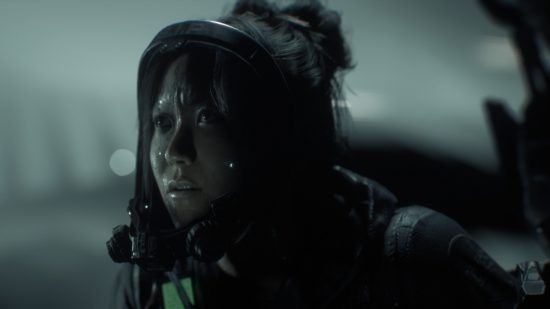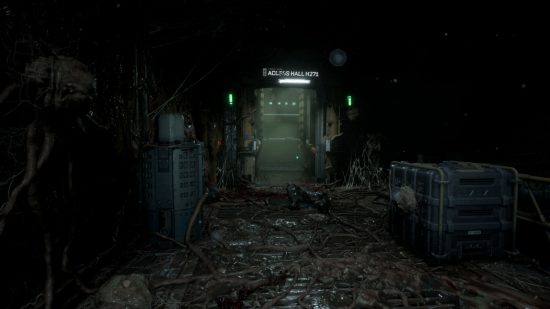I am not someone who traditionally enjoys playing horror games. I can’t sleep unless I know that all the doors in my house are locked and my gas hob is turned off, so the idea that I’d enjoy playing something that is designed to give me the heebie jeebies is honestly quite preposterous. But yet here I am, captivated by The Callisto Protocol knowing full well that I won’t sleep for weeks when I play it.
And in a way, I’m at peace with that.
After seeing Striking Distance’s upcoming survival horror behind closed doors at Gamescom, I’ve quickly come to realise that The Callisto Protocol is going to be a transformative experience for both my blood pressure and gaming as a whole. The developers – who are led by some of the best in the business in this genre – have really done their research into what makes a horror survival game both terrifying yet fun to play.
This is, in part, due to the game’s horror engineering – a term which developers have coined for the way in which they set their scares up. Horror engineering is based on five things: atmosphere, tension, brutality, helplessness, and humanity – and the game’s sequences will “appeal to different fears at different points of the game,” according to Striking Distance’s chief technical officer, Mark James. And that was made perfectly clear in the 14 minutes of gameplay shown to us behind closed doors.
In it, Jacob Lee is seen wandering around the prison, where dead guards litter the corridors and rooms, with their last messages written on the wall with blood. It’s clear The Callisto Protocol is leaning into environmental storytelling for the most part to help set the scene – and it works.

By the time we meet our first biophage, the stage is set. Except, while this one looks like the ones we’ve seen in trailers before, this ghoul is feeling frisky. As Jacob takes pop shots at it, tentacles come flying out of this thing’s face, giving you a very short window to take it down. If you miss, it mutates into what can only be described as nightmare fuel, wreaking havoc with your health and your limited supplies.
Mutation is the theme for The Callisto Protocol’s Gamescom showing, but if you dig a little bit deeper, you’ll see there’s much more to it. In one section, these spider-like biophages surround you. They look like humans, except they walk on all fours with their chest to the sky. It’s a grisly sight, especially when you discover they’ve been weaving a web, keeping some of your fellow inmates and guards captive.
As a fight ensues, I realise just how important audio is going to be in The Calisto Protocol. The sound of Jacob’s boots on the metal floor bounce off of every conceivable surface, giving off an echo that almost seems like it could be heard for miles. And while the biophages can hear you, you can also hear them.
This is where I remember that in space, no one can hear you scream.
These spider-like creatures, which James tells me are called Rushers, have an ability that basically turns them into a chameleon for a short period of time. They can blend with their environment, but you can still hear them sneaking around. And that’s done by design.
“You’ve seen the Rushers that crawl all over the ceiling,” James says. “Well you can hear those guys before you can see them.” This focus on providing three dimensional audio is heightened on the PlayStation 5 with the DualSense technology, and honestly, the more I hear about it, the more I believe it’ll be the platform to play The Callisto Protocol on.
“You can hear them positionally in 3D audio before you can see them,” he continues. “We couldn’t have done that on the last generation – we could only do that with the power of 3D audio processing on the consoles, so yes, we’ve leaned into that.”
Naturally that’s not the only thing Striking Distance has leaned into with the new generation of consoles. James has made no secrets that Striking Distance is looking to use haptic feedback in this game, but it wasn’t until he actually explained it to me that I realised just how far the developers are looking to push it.
Up until now, we’ve seen some pretty innovative uses of haptic feedback. But even the best PS5 games have struggled to integrate it flawlessly without it feeling like a gimmick. In The Callisto Protocol, the haptic feedback is a part of the horror engineering. “We are learning into haptics throughout,” James says. “Every shot you take, every collision you make with the baton has haptic feedback. There’s even haptic feedback on some of our scare sounds.”
James explains that if someone runs above you through a vent, you’ll feel it through the controller. As enemies get closer to you, you’ll feel their presence on the backside of the controller. “We want you to be fully immersed in the environment,” James says with a smile.
He’s smiling because he knows that the environment will steadily change as you work your way through the prison. Striking Distance has studied all of the horror film tropes and the games that have come before and there’ll be plenty of black cat scenarios here. With the vent system in particular, Grunts can use them to stalk you as you work your way through the prison. And sometimes, if you double back, you’ll see a vent grate just lying there on the floor.
Was that there before? What about that light? Was that on earlier?
These are all questions I ask myself before I go to sleep. The Callisto Protocol is going to be my worst nightmare, but with all this innovation, I find myself strangely drawn to it.

